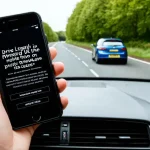Curated List of Top Navigation Devices for Vintage UK Car Dashboards
When selecting a navigation device for vintage cars, compatibility with the classic dashboard is paramount. Many modern units don’t align well with the unique dimensions and aesthetic of vintage car navigation compatibility requirements. Fortunately, some devices have been designed or adapted specifically for seamless integration.
Brands like RetroNav and ClassicDrive lead the market, offering models tailored to UK classic car tech enthusiasts. The RetroNav Classic 5-inch screen fits perfectly within traditional dashboard frames, maintaining the vintage look while providing up-to-date GPS functionality. ClassicDrive’s Navigator Pro model boasts user-friendly touchscreen controls and supports offline maps — an essential feature for UK rural drives.
Also read : Prolong your engine’s lifespan: best synthetic oils for high-mileage vehicles in the uk
Notable features across these devices include easy mounting kits, minimal wiring needs, and voice-guided navigation tailored for historic car interiors. Many devices also allow for Bluetooth connectivity, ensuring hands-free calling and enhanced safety.
| Device | Compatibility | Notable Features |
|---|---|---|
| RetroNav Classic | Designed for vintage dashboards | 5″ screen, offline maps, plug & play |
| ClassicDrive Pro | Fits UK classic car layouts | Touchscreen, Bluetooth, voice control |
Choosing these navigation devices guarantees reliable functionality without sacrificing the authentic vintage dashboard charm.
Also read : Top security solutions to protect your vintage british car from theft
Compatibility and Integration with Classic Dashboards
Ensuring harmony between modern tech and vintage style
Integrating modern devices into classic car dashboard compatibility requires meticulous attention to size, mount, and wiring. Many vintage dashboards were not designed with today’s electronics in mind. A successful retro-fit navigation system must fit precisely within the limited space, matching the dimensions and contours of the original instruments to avoid unsightly gaps or forced modifications.
Wiring is equally critical. Classic electrical systems often lack the connectors and power configurations needed by modern devices. Adapting these requires either custom wiring harnesses or professional rewiring, ensuring safety and functionality without damaging original components.
Aesthetic alignment is vital for enthusiasts who prize authenticity. Devices with custom-fit dash solutions deliver seamless integration, preserving the vintage dashboard’s look while providing modern navigation. Universal mounting options exist but may compromise the elegant, original appearance due to bulky brackets or non-standard shapes.
Some retro-fit products offer adjustable mounting kits compatible with various dashboard models. These options cater to diverse installation needs, balancing classic car dashboard compatibility with modern functionality elegantly and efficiently.
Installation Process and Ease of Use
Installing modern navigation systems in classic cars has become more accessible thanks to smart design focused on easy installation. Many systems offer non-invasive installation steps that do not require major modifications. Typically, installation involves connecting the unit to the car’s power source and mounting the display without altering the original dashboard. This preserves the car’s vintage look while upgrading its functionality.
User interfaces for these classic car tech upgrades prioritize simplicity. Designed with fewer buttons and intuitive menus, they ensure drivers unfamiliar with new tech can operate the system confidently. Touchscreen responsiveness and clear visual layouts make navigation effortless, even in older vehicles not originally built for digital controls.
Preserving dashboard originality is a key consideration. Manufacturers often produce mounting kits to integrate systems seamlessly, avoiding damage or noticeable changes to classic interiors. By choosing devices tailored for vintage models, owners can enjoy modern conveniences without compromising their car’s classic appeal. This balance between innovation and tradition enhances usability while respecting the vehicle’s heritage.
Features Favourable for UK Vintage Cars
When navigating UK roads, having offline maps navigation is essential, especially for vintage car owners who may prefer routes where mobile signal can be patchy. Offline maps ensure uninterrupted guidance without requiring continuous internet access, crucial for exploring rural areas and heritage routes popular with classic car enthusiasts.
A GPS designed specifically with UK roads GPS considerations enhances the driving experience. These include accurate positioning for complex roundabouts and adherence to local speed limits, which are often variable in historic zones. Such features help protect both the driver and the vintage vehicle by promoting safer, lawful driving.
Classic car GPS features often offer tailored voice guidance optimized for the cabin environment of older vehicles. Loud engine noise and minimal sound insulation can make subtle audio prompts ineffective. Clear, adjustable voice commands support drivers without distracting from the driving experience. Visibility is another factor; screens designed with high contrast and glare reduction ensure easier readability in bright UK daylight, aiding drivers who value clear instructions without compromising their focus on the road.
Aesthetic Design and Dashboard Harmony
Blending retro navigation look with modern tech creates a unique appeal in vintage vehicles. Many devices offer a seamless dash integration, ensuring that screens and controls don’t disrupt the classic interior vibe. This harmony is vital for enthusiasts who want functionality without sacrificing the vintage style car tech.
Customisation options play a key role here. Users can choose from various casings—matte black, brushed metal, or wood-effect—to match the existing dashboard. Screen types also vary, from small LED displays to larger touchscreens, providing flexibility. These options cater specifically to older models, preserving their aesthetic while upgrading technology.
For classic UK cars like the Jaguar E-Type or Mini Cooper, manufacturers have tailored devices to fit perfectly. This careful design respects the original lines and textures of the dashboard, blending modern interaction with vintage charm. The result is a dashboard that retains its authentic look while offering new convenience, appealing to drivers who want both style and innovation.
Reviews, Pros and Cons, and Recommended Sellers
Navigating the world of GPS devices can be daunting, but navigation device reviews UK provide valuable insights to ease this task. Expert and owner reviews consistently emphasize accuracy, ease of use, and update frequency. For example, devices praised in navigation device reviews UK often boast intuitive interfaces and reliable route calculations, earning high marks for everyday drivers.
A clear pro and con analysis is essential when selecting a device. Common pros include real-time traffic updates, voice commands, and wide map coverage. Conversely, cons often noted in navigation device reviews UK involve occasional signal loss in dense urban areas or limited battery life for certain models. Balancing these factors is crucial for making an informed purchase.
Trusted sellers play a pivotal role in this process. The best navigation devices recommended in navigation device reviews UK typically come from trusted navigation sellers with solid return policies and customer support. These sellers offer genuine products and ensure timely software updates.
Before purchasing, consider reading in-depth navigation device reviews UK to understand each model’s strengths and drawbacks fully. This approach guarantees you select a GPS that truly meets your needs.
Understanding Precision and Recall in Answer Evaluation
Precision and recall are crucial metrics for evaluating answer accuracy in datasets like SQuAD. Precision measures the proportion of correctly predicted tokens out of all tokens in the prediction. It answers the question: Of all tokens predicted, how many were correct? Mathematically, precision equals tp / (tp + fp), where:
- tp (true positives): tokens shared between the correct answer and the prediction.
- fp (false positives): tokens in the prediction but not in the correct answer.
Recall assesses how many tokens of the correct answer the prediction captured, answering: Of all correct tokens, how many did the prediction get? Recall is calculated as tp / (tp + fn), with:
- fn (false negatives): tokens in the correct answer but missing in the prediction.
By balancing precision and recall, you can gauge both how accurate and how complete a predicted answer is. High precision with low recall suggests predictions are accurate but incomplete, while high recall with low precision indicates many correct tokens but extra, incorrect ones.
Understanding these helps researchers and developers fine-tune models to improve the balance between exactness and coverage in answer predictions.


